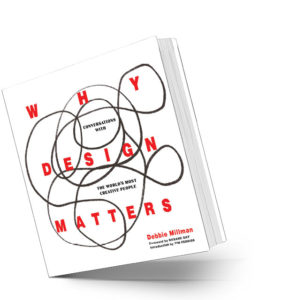For design legend Debbie Millman, design is the decisions we make, and the decisions we make compose our lives. That’s why, for Millman, the founder and host of legendary podcast Design Matters, design matters so much.
“We make decisions all day every day over the course of our lives to live a certain way. And that is what I believe design is—deliberate, conscious, full-hearted intention,” Millman says. “Every decision we make every day matters in the grand scheme of who we are. [It] contributes to the overarching theme of how we want to live. And so, I think design matters, you know, kind of more than anything.”
For the past 17 years, Millman has been sharing design’s importance with the world through her award-winning podcast. Today, nearly 500 interviews later, it has become one of the world’s longest-running podcasts and earned plenty of accolades, including a Cooper Hewitt National Design Award. Millman—also the author of seven books; co-founder of the world’s first graduate program in branding at the School of Visual Arts; co-owner and editorial director of PRINT Magazine; president emeritus of AIGA; and an artist and illustrator featured in some of the world’s most prestigious publications and institutions—has included over 50 of her favorite interviews (including Brené Brown, Alain de Botton, Tim Ferriss, David Byrne and Cheryl Strayed) in a recently released book, Why Design Matters: Conversations With the World’s Most Creative People. It’s a kind of compendium that she hopes answers both why design matters and why she created the podcast.

Including a foreward by Roxane Gay (Millman’s wife and a renowned writer), an introduction by Tim Ferriss and an afterward by Maria Popova, the book is grounded in the interviews and divided into five sections: Legends, Truth Tellers, Culture Makers, Trendsetters and Visionaries.
“In these pages, you will find conversations with the world’s most renowned designers, artists, writers, and public thinkers. You will read about their most enviable successes, the devastating failures that almost derailed their careers, the joys and sorrows of their personal lives, and how they’ve given themselves over to the act of creation,” writes Millman in the book’s introductory essay.
Her essay also tells the origin story of the podcast: how she turned an opportunity into a chance to “resurrect [her] creative spirit” which had been lost in the years of her relentless professional pursuits. It gives insight into one of the world’s top interviewers, detailing Millman’s painstaking preparation process and ultimately her love for research. And it details the evolution of the show.
“I’ve discovered that the arc of a creative life is a circuitous one, and I am endlessly fascinated by how people become who they are and how the decisions they make over the course of their lives impacts their work,” Millman writes. “Design Matters [which began as a show about designers talking about design] is now a show about how the most creative people in the world create their lives.”
The decisions Truth Teller Brené Brown have made include choosing to own her story. The decisions that Legend Seth Godin have made include continuing to persevere despite 900 rejection letters. The decisions Millman has made include declining an offer to be CEO of Sterling Brands, the leading branding consultancy where she’d been president for nearly 20 years. In that time, she helped grow the company from 15 people to 150 and from one office to five offices—one of them a floor of the Empire State Building before her departure. This marked her shift to living intentionally. Living with intention, Millman believes, is ultimately the key to designing a well-lived life, one in which we thrive professionally and personally. For Millman, intention is ultimately what design is and why it’s so important.
“You never know where you’re going to end up. But, I think there’s also a difference between going after things that you want as opposed to waiting for things to happen.”
The luminaries featured in the book don’t wait despite insecurity, despite being plagued by a constant nag of not being satisfied.
“A lot of people don’t start things because they’re waiting for the right feeling to occur to help inspire that pathway,” Millman says. “And I think it’s interesting to be able to look at these people with these paradoxical sort of glasses on and think, Oh, OK, you don’t have to wait for anything; you can just do it and still have all those feelings.”
Millman speaks slowly and deliberately, often pausing to give the most thoughtful response. She readily admits that it’s her own insecurity that led to a past life living less intentionally. Yet she also credits this insecurity as a key ingredient to her success, along with “[her own] hunger and longing for more, big dreams, a vivid imagination and a resilient spirit.”
“Roxane [Gay] has pointed out to me that I have very high expectations for what I want my life to be about, and every time I achieve something, I just raise the bar higher as opposed to just swinging on the bar,” Millman says. After a thoughtful pause, she adds, “And I don’t really have an answer for why [a slight pause] I can’t [another pause] rest,” she ends with emphasis and a hint of exhaustion. “But I also don’t want to, so maybe that’s the answer.”
Millman has more questions than answers. Her constant questioning and curiosity drive her forward.
It’s part of the design of Debbie Millman that she’ll keep asking questions until she finds answers. Until she draws some conclusion. Until it leads to the next question. And the next. That’s why design matters.
This article originally appeared in the September/October 2022 Issue of SUCCESS magazine. Photo by John Madere






